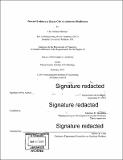Directed evolution in human cells via adenoviral replication
Author(s)
Berman, Chet Michael.
Download1103321139-MIT.pdf (20.28Mb)
Other Contributors
Massachusetts Institute of Technology. Department of Chemistry.
Advisor
Matthew D. Shoulders.
Terms of use
Metadata
Show full item recordAbstract
The discovery and optimization of biomolecules that reliably function in metazoan cells is imperative for both basic biological research, and therapeutic development. Typically, researchers turn to directed evolution either in vitro, in bacteria, or in yeast, to mutate, select, and amplify biomolecules of interest (BOls) with new and highly-tailored activities. Unfortunately, BOIs evolved in these environments often fail to function when translated into the complex environment of metazoan cells. Unique metazoan biology such as sophisticated proteostasis networks, complex cell signaling pathways, distinctive post-translational modifications, cellular trafficking, and highly regulated chromatin architecture can all derail the activity of BOIs evolved in simpler systems. Current approaches to directed evolution in metazoan cells rely on labor-intensive and time-consuming screening approaches that have a high potential for false positives. Robust approaches for directed evolution directly in human cells are profoundly needed. In this thesis, I describe the development, characterization, and application of a broadly applicable platform for directed evolution of diverse BOIs directly in human cells. The platform relies on a partially gutted adenovirus lacking multiple genes, including the essential DNA polymerase and protease genes, features that allow us to evolve BOIs encoded by genes as large as 7 kb while attaining the mutation rates and enforcing the selection pressure required for successful directed evolution of complex function. High mutagenesis rates are attained by trans-complementation of an engineered, highly error-prone form of the adenoviral polymerase. Selection pressure that couples desired BOI functions to adenoviral propagation is achieved by linking the functionality of the encoded BOI to the production of adenoviral protease activity by the human cell. This platform makes it possible, in principle, to evolve any biomolecule activity that can be coupled to protease expression or activation by serially passaging adenovirus carrying the BOI. As proof-of- concept, we use the platform to evolve, directly in the human cell environment, several transcription factor variants that maintain high levels of function while gaining resistance to a small molecule inhibitor. We anticipate that this platform will substantially expand the repertoire of biomolecules that can be reliably and robustly engineered for both research and therapeutic applications in metazoan systems.
Description
Thesis: Ph. D., Massachusetts Institute of Technology, Department of Chemistry, 2019 Cataloged from PDF version of thesis. Includes bibliographical references.
Date issued
2019Department
Massachusetts Institute of Technology. Department of ChemistryPublisher
Massachusetts Institute of Technology
Keywords
Chemistry.